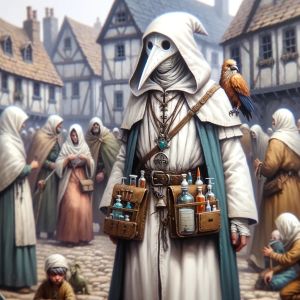Brigit: Difference between revisions
(Created page with "{{Infobox Deity | name = Brigit | image = IMG0014 - Brigit.jpg | title = The Crying Goddess, The Lady of Tears | symbol = A silver bowl filled with water | level = Intermediate | alignment = Lawful Good | allowed_alignments = LG, NG, LN | primary_portfolio = Family, Grief, Healing, Health | secondary_portfolio = Birth, Hospitality, Loss, Love, Medicine, Mercy | weapon = Shortsword }} File:IMG0042 - Brigit.jpg|left|thumb|300px|Brigit, deity of grief, healing and family...") |
No edit summary |
||
| Line 1: | Line 1: | ||
[[es:Brigit|Español]] | |||
[[ca:Brigit|Català]] | |||
{{Infobox Deity | {{Infobox Deity | ||
| name = Brigit | | name = Brigit | ||
Revision as of 09:40, 10 July 2024

Brigit, deity of grief, family and healing, is an ancient and venerable presence within the Celestial Pantheon. She embodies the essence of compassion and benevolence. Her existence, spanning countless ages, has deeply intertwined her with the multifaceted nature of grief, healing, and family. Profoundly empathetic, she feels the sorrows of her followers as if they were her own, a testament to her boundless compassion. Her own experiences with great loss have profoundly shaped her being, driving her to alleviate the suffering of others, sparing them the depths of despair she knows all too well. This has made her the multiverse's greatest advocate for healing, both magical and mundane, with a ceaseless endeavor to eradicate ailments in all their forms.
Brigit's nurturing spirit is akin to that of a mother's, protective and caring, with a particular reverence for the family unit. She stands as a guardian over the cycle of life, embracing its every stage with grace and understanding. In her presence, one finds solace and sanctuary, a respite from the harsh realities of the world. Her divine influence manifests in the most compassionate aspects of life, guiding her followers to not only heal the body but also mend the soul. In Brigit's embrace, there is a profound sense of peace, an assurance that amidst life's trials and tribulations, her unwavering love and support remain a constant beacon of hope and healing.
Her appearance reflects her gentle yet powerful nature: she is envisioned as a woman of stunning beauty, with long, well-kept auburn hair adorned with simple ornaments. She dons white robes accented with touches of turquoise, complemented by pieces of radiant armor that symbolize her protective nature. In her alternate form as a pegasus, Brigit exudes celestial grace. She possesses a coat of silky silver, shimmering like moonlight, and wings that unfold with awe-inspiring majesty. Her eyes, deep and knowing, offer solace and understanding. As she spreads her grand wings, preparing for flight, she embodies freedom, hope, and the transcendent beauty of the spirit.
Symbol
Brigit's holy symbol is a striking silver disk, at its center a beautifully crafted bowl ornamented with turquoise. The bowl is depicted as being gently filled with drops of water, a symbol of purity and healing.
Relations With Other Deities
Brigit has long stood as a pillar of benevolence and compassion. Her presence, ancient and revered, is like a nurturing light that has warmed the hearts of deities and mortals alike through countless ages. Her wisdom in the realms of healing and medicine is not only a beacon of hope but a powerful tool for those who confront the shadows of evil. Brigit's essence is the embodiment of empathy and care, traits that have earned her deep respect across the Pantheon. She views the deities of good not merely as peers but as members of an extended celestial family. Her influence is like a gentle, binding force, strengthening the ties between the deities, fostering unity and harmony where discord might otherwise take root.
Amongst these divine relationships, her bond with Aerion, the deity of the sun, shines particularly bright. Aerion, her beloved son, shares with her one of the most profound connections known in the multiverse. Their love is a testament to the strength and depth of familial bonds, transcending the mere notion of divinity. Together, their combined radiance of warmth and light symbolizes the enduring power of love and the unwavering resilience of life itself.
However, Brigit's perspective on the balance of life and death is complex. While she despises the evil ways of Nessus, she acknowledges the inevitability of death as a part of life's cycle. This understanding reflects her deep connection with the natural rhythms of existence, recognizing the necessity of endings as precursors to new beginnings. In recent times, she has come to resents and even despise Thonoxum, deity of diseases. His actions, which cause suffering and premature demise, are antithetical to Brigit's ideals. She sees these afflictions as unnecessary and cruel, disrupting the natural course of long and healthy lives.
What The Legends Say
This is in a state of significant expansion or restructuring We hope we can have this content ready soon. |

Dogma

Brigit dogma has these principles as foundation:
- Celebrate Life and Health: Revere and nurture the gift of health in oneself and others. Embrace practices that promote physical and emotional well-being, acknowledging that a healthy community is a strong community.
- Pursue Knowledge in Healing: Seek wisdom in the arts of healing and medicine. Honor Brigit by learning and sharing knowledge of both magical and non-magical healing practices, for through healing, we manifest her divine essence in the world.
- Alleviate Suffering: Extend a hand of comfort to those in grief and pain. Offer solace and aid to the bereaved and the suffering, for in easing the burdens of others, we honor Brigit's compassion.
- Cherish and Protect Family: Uphold the sanctity of family in all its forms. Honor the bonds of kinship and friendship as sacred, and strive to resolve conflicts with understanding and compassion.
- Practice Mercy and Hospitality: Show kindness and hospitality to all, especially to those in need. Be a beacon of hope and a safe haven, just as Brigit embraces all with her benevolent spirit.
Clergy and Temples

In the sacred order dedicated to Brigit, the deity of healing, grief, and family, the clergy is predominantly composed of pure clerics, each bound by a deep commitment to their divine patron. This order is well-structured, boasting a solid hierarchy that organizes its members into specialized branches, each aligning with their innate skills and divine calling.
Healers, the wandering souls of the order, traverse the lands, offering their services to the wounded and the ill. They are not just caregivers but also gatherers of knowledge, collecting information on emerging diseases and ailments to share with their scholarly counterparts.
Researchers, in close collaboration with the healers, delve into the mysteries of illnesses and injuries. Their mission is profound – to study, understand, and innovate in the realms of treatment and medicine. They blend the wisdom of the natural world with the arcane, constantly seeking new methods to alleviate suffering.
Battle clerics represent the order's martial aspect. They are the stalwart defenders against evil, standing against those forces that bring harm, grief, and suffering to the innocent. These clerics embody Brigit's protective spirit, serving as guardians against the darkness that threatens the sanctity of life.
A natural compassion for those in grief is a hallmark of Brigit's clerics. It is common for them to pause in their journeys to offer counsel, advice, or simply a comforting presence to those mourning a loss. This empathy is a reflection of Brigit's own deep connection with the nature of grief.
Clerics of Brigit often find themselves serving within the communities they reside in. They are known to officiate sacred rites of passage for the dying, specially in the absence of a cleric from the dying person's own faith. This practice highlights their universal role as emissaries of comfort and solace. They also perform joyous ceremonies like marriages, where they invoke Brigit’s blessing upon the new union and the family being formed. These clerics are also highly sought after to assist in births, not only for their medical expertise but also to ensure that Brigit's blessing is bestowed upon the life of the newborn. Their presence at these critical moments of life – birth, marriage, and death – symbolizes the deity’s encompassing involvement in the full cycle of human existence, from the joy of new beginnings to the solemnity of final farewells. Through these rites, the clerics of Brigit manifest her divine essence, nurturing and protecting the community in all stages of life.
The temples of Brigit, mirroring the ethos of her clergy, are predominantly situated within communities, allowing for a more direct and meaningful service to the people. These temples often function as houses of care, providing refuge and treatment for the ill and injured. In larger cities, these temples also serve as centers of research, contributing to the broader understanding and treatment of diseases.
As a result, temples dedicated to Brigit tend to be elaborate structures, reflecting their multifaceted role as places of worship, healing, and learning. Their architecture and design often embody the principles of Brigit herself, offering a sanctuary of peace, healing, and knowledge to all who seek her blessing.
Initiation
The process of accepting Brigit as a patron deity is marked by a period of preparation and reflection, beginning one year prior to the initiate's coming of age. Those seeking to dedicate themselves to Brigit must first journey to a temple of Brigit, either within their own community or the nearest one available. There, they express their intention to a cleric, and the temple warmly welcomes them into its fold.
During this pivotal year, the initiate is immersed in service to the community, often aiding the clerics in caring for the wounded or assisting in various ceremonies. This period is not only about physical service but also about spiritual growth and contemplation. The initiate is expected to spend at least one hour each day reflecting on the aid they have provided in Brigit's name, contemplating the impact of their actions and the embodiment of Brigit's virtues.
The culmination of this year-long journey is a day of total meditation. This final day is dedicated to introspection, considering both the accomplishments of the past year and the expectations and responsibilities that come with being a follower of Brigit. It is a time of deep personal reflection, evaluating one's readiness to fully embrace the path ahead.
The following day marks a new beginning. The initiate presents themselves before the cleric to make a solemn offer: to live a life of service, aiding those in need and actively contributing to their community, in alignment with Brigit's teachings. In response, the cleric performs the initiation spell, a sacred rite that forges a spiritual bond between the initiate and Brigit.
After this profound ceremony, the new follower returns to their normal life, now transformed. They carry with them a lasting connection to Brigit and a lifelong commitment to uphold her ideals, always ready to extend a helping hand to those in need. This initiation marks not just a personal milestone but a pledge to live in service of the higher principles Brigit embodies.

